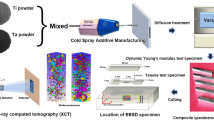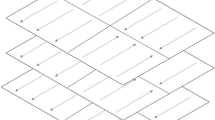Abstract
PMMA/β-TCP composites were evaluated to be suitable for laser sintering earlier, but the possible after effects are not known yet. Effects of sintering on the biological nature and the influences of critical compositions and process parameters have not been investigated so far. The current research attempts this, first identifying experimentally the most suitable laser process conditions for the specific grades of PMMA and β-TCP and then subjecting single layer sintered samples to FTIR analysis and in vitro studies involving MTT and ALP assays, alizarin red S tests, and real-time PCR analyses. While the laser interactions are not detrimental, the biological responses are generally positive proving the selective laser sintering of PMMA/β-TCP composites to be a potential approach for specific medical applications.








Similar content being viewed by others
References
D. Logeart-Avramoglou, F. Anagnostou, R. Bizios, and H. Petite: Engineering bone: Challenges and obstacles. J. Cell Mol. Med. 9, 972–984 (2005).
B. Ben-Nissan: Natural bioceramics: From coral to bone and beyond. Curr. Opin. Solid State Mater. Sci. 7, 283–288 (2003).
J.M. Lane, E. Tomin, and M.P.G. Bostrom: Biosynthetic bone grafting. Clin. Orthop. Relat. Res. 367, S107–S117 (1999).
R.R. Pelker and G.E. Friedlaender: Biomechanical aspects of bone autografts and allografts. Orthop. Clin. N. Am. 18, 235–239 (1987).
H.J. Mankin, M.C. Gebhardt, L.C. Jennings, D.S. Springfield, and W.W. Tomford: Long term results of allograft replacement in the management of bone tumors. Clin. Orthop. Relat. Res. 324, 86–97 (1996).
D.M. Strong, G.E. Friedlaender, W.W. Tomford, D.S. Springfield, T.C. Shives, H. Bur-chardt, W.F. Enneking, and H.J. Mankin: Immunologic responses in human recipients of osseous and osteochondral allografts. Clin. Orthop. Relat. Res. 326, 107–114 (1996).
R.J. Simonds, S.D. Holmberg, R.L. Hurwitz, T.R. Coleman, S. Bottenfield, L.J. Conley, S.H. Kohlenberg, K.G. Castro, B.A. Dahan, C.A. Schable, M.A. Rayfield, and M.F. Rogers: Transmission of human-immunodeficiency-virus type-1 from a seronegative organ and tissue donor. N. Engl. J. Med. 326, 726–732 (1992).
S. Jensen, M. Aarboe, E. Pinholt, E. Hjorting-Hansen, F. Melsen, and I. Ruyter: Tissue reaction and material characteristics of four bone substitues. Int. J. Oral Maxillofac. Implants 11, 55–66 (1996).
W.R. Moore, S.E. Graves, and G.I. Bain: Synthetic bone graft substitutes. Aust. N. Z. J. Surg. 71, 354–361 (2001).
F.H. Albee and H.F. Morrison: Studies in bone growth: Triple CaP as a stimulus to osteogenesis. Ann. Surg. 71, 32–39 (1920).
R.D. Goodridge, K.W. Dalgarno, and D.J. Wood: Indirect selective laser sintering of an appetite-mullite glass-ceramic for potential use in bone replacement applications. Proc. Inst. Mech. Eng., Part H 220, 57–68 (2006).
A. Asti and L. Gioglio: Natural and synthetic biodegradable polymers: Different scaffolds for cell expansion and tissue formation. Int. J. Artif. Organs 37, 187–205 (2014).
I. Vroman and L. Tighzert: Biodegradable polymers. Materials 2, 307–344 (2009).
A.C. Taş, F. Korkusuz, M. Timuçin, and N. Akkaş: An investigation of the chemical synthesis and high-temperature sintering behaviour of calcium hydroxyapatite (HA) and tricalcium phosphate (TCP) bioceramics. J. Mater. Sci.: Mater. Med. 8, 91–96 (1997).
O. Gauthier, E. Goyenvalle, J.M. Bouler, J. Guicheux, P. Pilet, P. Weiss, and G. Daculsi: Macroporous biphasic calcium phosphate ceramics versus injectable bone substitute: A comparative study 3 and 8 weeks after implantation in rabbit bone. J. Mater. Sci. Mater. Med. 12, 385–390 (2001).
R.M. Baxter, D.W. Macdonald, S.M. Kurtz, and M.J. Steinbeck: Severe impingement of lumbar disc replacements increases the functional biological activity of polyethylene wear debris. J. Bone Jt. Surg. Am. Vol. 95, e751–e759 (2013).
H. Kim, H.M. Kim, J.E. Jang, C.M. Kim, E.Y. Kim, D. Lee, and G. Khang: Osteogenic differentiation of bone marrow stem cell in poly(lactic-co-glycolic acid) scaffold loaded various ratio of hydroxyapatite. Int. J. Stem Cells 6, 67–74 (2013).
K. Seunarine, N. Gadegaard, M. Tormen, D.O. Meredith, M.O. Riehle, and C.D.W. Wilkinson: 3D polymer scaffolds for tissue engineering. Nanomedicine 1, 281–296 (2006).
C.M. Agrawal and R.B. Ray: Biodegradable polymeric scaffolds for musculoskeletal tissue engineering. J. Biomed. Mater. Res. 55, 141–150 (2001).
D.J. Mooney and R.S. Langer: Engineering biomaterials for tissue engineering. In The Biomedical Engineering Handbook, J.D. Bronzino, ed. (CRC Press, Boca Raton, 1995); pp. 109/1–109/8.
W. Bonfield, M. Wang, and K.E. Tanner: Interfaces in analogue biomaterials. Acta Mater. 46, 2509–2518 (1998).
R.C. Thomson, A.K. Shung, M.J. Yaszemski, and A.G. Mikos: Polymer scaffold processing. In Principles of Tissue Engineering, R.P. Lanza, R. Langer, and J. Vacanti, eds. (Academic Press, San Diego, 2000); pp. 251–262.
M.S. Widmer and A.G. Mikos: Fabrication of biodegradable polymer scaffolds for tissue engineering. In Frontiers in Tissue Engineering, C.W. Patrick, A.G. Mikos, and L.V. Mcintyre, eds. (Elsevier Sciences, New York, 1998); pp. 107–120.
L.E. Niklason and R. Langer: Prospects for organ and tissue replacement. JAMA, J. Am. Med. Assoc. 285, 573–576 (2001).
K.F. Leong, C.M. Cheah, and C.K. Chua: Solid freeform fabrication of three- dimensional scaffolds for engineering replacement tissues and organs. Biomaterials 24, 2363–2378 (2003).
C.K. Chua and K.F. Leong: Rapid Prototyping: Principles and Applications in Manu-facturing, 2nd ed. (World Scientific, Singapore, 2003).
M.W. Naing, C.K. Chua, and K.F. Leong: Computer aided tissue engineering scaffold fabrication. In Virtual Prototyping & Bio Manufacturing in Medical Applications (Springer, Boston, MA, 2008); pp. 67–85.
L. Hao, M.M. Savalani, Y. Zhang, K.E. Tanner, and R.A. Harris: Selective laser sintering of hydroxyapatite reinforced polyethylene composites for bioactive implants and tissue scaffold development. Proc. Inst. Mech. Eng., Part H 220, 521–531 (2006).
M.M. Savalani, L. Hao, and R.A. Harris: Evaluation of CO2 and Nd:YAG lasers for the selective laser sintering of HAPEX®. Proc. IME B J. Eng. Manufact. 220, 171–182 (2006).
M. Jarcho, J.F. Kay, and K.l. Gumaer: Tissue cellular and subcellular events at a bone ceramic hydroxyapatite interface. J. Bioeng. 1, 79 (1977).
S.J. Kalita, S. Bose, H.L. Hosick, and A. Bandyopadhyay: Development of controlled porosity polymer–ceramic composite scaffolds via fused deposition modeling. Mater. Sci. Eng., C 23, 611–620 (2003).
B. Duan, M. Wang, W.Y. Zhou, W.L. Cheung, Z.Y. Li, and W.W. Lu: Three-dimensional nanocomposite scaffolds fabricated via selective laser sintering for bone tissue engineering. Acta Biomater. 6, 4495–4505 (2010).
G. Lewis: Properties of antibiotic-loaded acrylic bone cements for use in cemented arthroplasties. J. Biomed. Mater. Res., Part B 89, 558–574 (2009).
M. Puska, A. Kokkari, T. Närhi, and P. Vallittu: Mechanical properties of oligomer modified acrylic bone cement. Biomaterials 24, 417–425 (2003).
M. Descamps, O. Richart, P. Hardouin, J.C. Hornez, and A. Leriche: Synthesis of macroporous β-tricalcium phosphate with controlled porous architectural. Ceram. Int. 34, 1131–1137 (2008).
R. Velu and S. Singamneni: Selective laser sintering of polymer biocomposites based on polymethyl methacrylate. J. Mater. Res., 29, 1883–1892 (2014).
S. Lohfeld, S. Cahill, V. Barron, P. McHugh, L. Dürselen, L. Kreja, C. Bausewein, and A. Ignatius: Fabrication, mechanical and in vivo performance of polycaprolactone/tricalciumphosphate composite scaffolds. Acta Biomater. 8, 3446–3456 (2012).
R. Velu and S. Singamneni: Evaluation of the influences of process parameters while selective laser sintering PMMA powders. Proc. Inst. Mech. Eng., Part C 229, 603–613 (2014).
A. Rudin and P. Choi: The Elements of Polymer Science & Engineering (Academic Press, Chicago, 2012).
P. Rantuch, D. Kačíková, and B. Nagypál: Investigation of activation energy of polypropylene composite thermos oxidation by model-free methods. Eur. J. Environ. Saf. Sci. 2, 12–18 (2014).
D. Jang, T. Nguyen, S.K. Sarkar, and B. Lee: Microwave sintering and in vitro study of defect-free stable porous multi-layered Hap-ZrO2 artificial bone scaffold. Sci. Technol. Adv. Mater. 13, 035009 (9pp) (2012).
C.A. Gregory, W.G. Gunn, A. Peister, and D.J. Prockop: An Alizarin red-based assay of mineralization by adherent cells in culture: Comparison with cetylpyridinium chloride extraction. Anal. Biochem. 329, 77–84 (2004).
R. Ma, S. Tang, H. Tan, W. Lin, Y. Wang, J. Wei, L. Zhao, L. Zhao, and T.T. Preparation: Characterization, and in vitro osteoblast functions of a nano-hydroxyapatite/polyetheretherketone biocomposite as orthopedic implant material. Int. J. Nanomed. 9, 3949–3961 (2014).
S. Tsai, H. Liou, C. Lin, K. Kuo, Y. Hung, R. Weng, and F. Hsu: MG63 osteoblast-like cells exhibit different behavior when grown on electrospun collagen matrix versus electrospun gelatin matrix. PLoS One 7, e31200 (2012).
T.D. Schmittgen and K.J. Livak: Analyzing real-time PCR data by the comparative CT method. Nat. Protoc. 3, 1101–1108 (2008).
H. Yokozeki, T. Hayashi, T. Nakagawa, H. Kurosawa, K. Shibuya, and K. Ioku: Influence of surface microstructure on the reaction of the active ceramics in vivo. J. Mater. Sci. Mater. Med. 9, 381–384 (1998).
L. Hao, J. Lawrence, and K.S. Chian: On the effects of CO2 laser irradiation on the surface properties of a magnesia partially stabilised zirconia (MgO-PSZ) bioceramic and the subsequent improvements in human osteoblast cell adhesion. J. Biomater. Appl. 19, 81–105 (2004).
V.L. Tsang and S.N. Bhatia: Three-dimensional tissue fabrication. Adv. Drug Deliv. Rev. 56, 1635–1647 (2004).
G. Duan, C. Zhang, A. Li, X. Yang, L. Lu, and X. Wang: Preparation and characterization of mesoporous zirconia made by using a poly(methyl methacrylate) template. Nanoscale Res. Lett. 3, 118 (2008).
L. Di Silvio, M.J. Dalby, and W. Bonfield: In vitro response of osteoblasts to hydroxyapatite-reinforced polyethylene composites. J. Mater. Sci. Mater. Med. 9, 845–848 (1998).
K.B. Muhammad, W.A. Abas, K.H. Kim, B. Pingguan-Murphy, N.M. Zain, and H. Akram: In vitro comparative study of white and dark polycaprolactone trifumarate in situ cross-linkable scaffolds seeded with rat bone marrow stromal cells. Clinics 67, 629–637 (2012).
S.S. Kim, M.S. Park, O. Jeon, C.Y. Choi, and B.S. Kim: Poly(lactide-co-glycolide)/hydroxyapatite composite scaffolds for bone tissue engineering. Biomaterials 27, 399–409 (2006).
L. Sun, B. Gan, Y. Fan, F. Zhuang, and Q. Hu: The proliferation and gene expression in MC3T3-E1 under simulated microgravity. In Complex Medical Engineering, 2007. CME 2007. IEEE/ICME International Conference (IEEE, Beijing, China, 2007); pp. 1803–1806.
S.B. Sulaiman, T.K. Keong, C.H. Cheng, A.B. Saim, and R.B.H. Idrus: Tricalcium phosphate/hydroxyapatite (TCP–HA) bone scaffold as potential candidate for the formation of tissue engineered bone. Indian J. Med. Res. 137, 1093–1101 (2013).
M. Gumusderelioglu, E.O. Tuncay, G. Kaynak, T.T. Demirtas, S.T. Aydin, and S.S. Hakki: Encapsulated boron as an osteconductive agent for bone scaffolds. J. Trace Elem. Med. Biol. 31, 120–128 (2015).
S. Yamano, T.Y. Lin, J. Dai, K. Fabella, and A.M. Moursi: Bioactive collagen membrane as a carrier for sustained release of PDGF. J. Tissue Sci. Eng. 2, 110 (2011).
L. Xu, K. Lv, W. Zhang, X. Zhang, X. Jiang, and F. Zhang: The healing of critical-size calvarial bone defects in rat with rhPDGF-BB, BMSCs, and β-TCP scaffolds. J. Mater. Sci. Mater. Med. 23, 1073–1084 (2012).
A. Balamurugan, S. Kannan, V. Selvaraj, and S. Rajeswari: Development and spectral characterization of poly(methyl methacrylate)/hydroxyapatite composite for biomedical applications. Trends Biomater. Artif. Organs 18, 41–45 (2004).
Author information
Authors and Affiliations
Corresponding author
Rights and permissions
About this article
Cite this article
Velu, R., Kamarajan, B.P., Ananthasubramanian, M. et al. Post-process composition and biological responses of laser sintered PMMA and β-TCP composites. Journal of Materials Research 33, 1987–1998 (2018). https://doi.org/10.1557/jmr.2018.76
Received:
Accepted:
Published:
Issue Date:
DOI: https://doi.org/10.1557/jmr.2018.76




